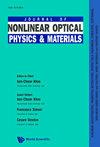Weyl电荷密度波化合物(TaSe4)2I的光诱导能带结构变化
IF 2.3
4区 物理与天体物理
Q2 OPTICS
引用次数: 4
摘要
集体模式是拓扑材料中新量子相出现的原因。在准一维(1D) Weyl半金属(TaSe4)2I中,电荷密度波(CDW)在Weyl点打开带隙,从而将系统转变为轴子绝缘体。熔化CDW将恢复Weyl相,但一维波动将间隙区扩展到远高于3D转变温度(T CDW = 263 K)的位置,从而阻碍了传统光谱方法对这种拓扑相变的研究。本文采用非平衡方法:通过光激发扰动CDW相,并通过时间分辨和角度分辨光电子能谱监测能带结构的动态演变。我们发现,在光激发下,电子填充了费米能级的线性色散态,并填补了CDW间隙。载流子居数和带隙重整化(BGR)动力学均表现出数百飞秒特征时间尺度的快速分量。然而,BGR在µs时间尺度上也表现出第二个慢分量。超快响应和在E - F处光谱权重的持续变化的结合,以及由此产生的线性色散态对光激发的灵敏度,可以解释(TaSe4)2I作为宽带红外光电探测器材料的高性能。本文章由计算机程序翻译,如有差异,请以英文原文为准。
Optically induced changes in the band structure of the Weyl charge-density-wave compound (TaSe4)2I
Collective modes are responsible for the emergence of novel quantum phases in topological materials. In the quasi-one dimensional (1D) Weyl semimetal (TaSe4)2I , a charge density wave (CDW) opens band gaps at the Weyl points, thus turning the system into an axionic insulator. Melting the CDW would restore the Weyl phase, but 1D fluctuations extend the gapped regime far above the 3D transition temperature (T CDW = 263 K), thus preventing the investigation of this topological phase transition with conventional spectroscopic methods. Here we use a non-equilibrium approach: we perturb the CDW phase by photoexcitation, and we monitor the dynamical evolution of the band structure by time- and angle-resolved photoelectron spectroscopy. We find that, upon optical excitation, electrons populate the linearly dispersing states at the Fermi level (E F ), and fill the CDW gap. The dynamics of both the charge carrier population and the band gap renormalization (BGR) show a fast component with a characteristic time scale of a few hundreds femtoseconds. However, the BGR also exhibits a second slow component on the µs time scale. The combination of an ultrafast response and of persistent changes in the spectral weight at E F , and the resulting sensitivity of the linearly dispersing states to optical excitations, may explain the high performances of (TaSe4)2I as a material for broadband infrared photodetectors.
求助全文
通过发布文献求助,成功后即可免费获取论文全文。
去求助
来源期刊
CiteScore
3.00
自引率
48.10%
发文量
53
审稿时长
3 months
期刊介绍:
This journal is devoted to the rapidly advancing research and development in the field of nonlinear interactions of light with matter. Topics of interest include, but are not limited to, nonlinear optical materials, metamaterials and plasmonics, nano-photonic structures, stimulated scatterings, harmonic generations, wave mixing, real time holography, guided waves and solitons, bistabilities, instabilities and nonlinear dynamics, and their applications in laser and coherent lightwave amplification, guiding, switching, modulation, communication and information processing. Original papers, comprehensive reviews and rapid communications reporting original theories and observations are sought for in these and related areas. This journal will also publish proceedings of important international meetings and workshops. It is intended for graduate students, scientists and researchers in academic, industrial and government research institutions.

 求助内容:
求助内容: 应助结果提醒方式:
应助结果提醒方式:


